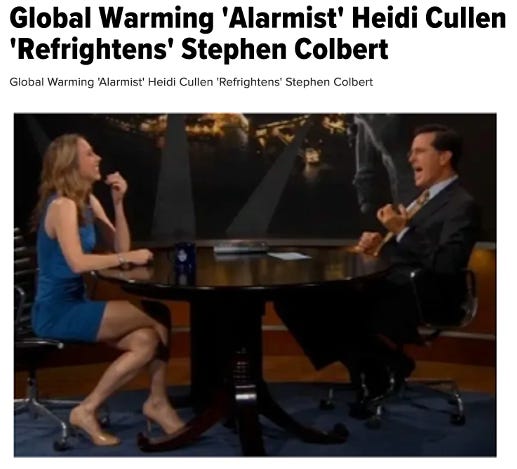The First Rule of Climate Change Communication
Don't talk about climate change
Once upon a time, I was in a VC-backed start-up building a weather derivative solution for consumer businesses.
As part of that venture, I participated in many sales meetings with executives, primarily CFOs and Treasurers in the US and Canada.
Ahead of one such meeting with the CFO of a large theme park chain, our sponsor warned us that we should absolutely avoid referring to climate change or, worse, global warming. It was a triggering word for the CFO, and he advised us that if we brought that topic up, the meeting would effectively be over.
It was good advice.
The CFO was happy to discuss the growing impact of increasingly volatile weather events on his business. We focused on how he could use a weather derivative solution to minimize the risk of unseasonable weather and the resulting revenue losses from reduced attendance at his parks.
He didn’t end up buying our solution (he wasn’t that smart, frankly), but we were able to have a good meeting while discussing his “climate” change problem without talking about, you know, climate change.
That experience has framed my approach to the climate conversation ever since.
“Climate is nothing more than a million little weathers” — Stephen Colbert
Dr. Heidi Cullen, The Weather Channel’s first on-air climate expert, wrote a terrific book called The Weather of the Future and, as part of the marketing effort, appeared on The Colbert Report in 2010.
It was a terrific segment.
Sadly, I can no longer find a digital version online, but the one line I took away and have been paraphrasing ever since was Stephen’s comment that “… the climate is nothing more than a million little weathers.”
It’s hard to argue with that.
By the way, for those unfamiliar with The Colbert Report, here’s the intro to what was, in my opinion, one of the best (and funniest) political satires ever produced.
Chicken little …
Responsibility for communication lies with the communicator.
Full stop.
If the message a person or organization is trying to convey isn’t breaking through to the intended audience, it’s not the fault of the audience.
The problem to date with mainstream messaging about the climate change problem (and I’ve been guilty of this as well) is that it often comes across to “civilians” as high-minded, scolding, removed from the realities of today and occasionally condescending.
That tone leads to a chicken little vibe that turns off a large portion of the population.
Refocusing the discussion to the fact that the climate has changed, and we are already reaping some of what we’ve sowed in the form of increasingly high impact weather events, is a far more effective way to communicate the challenges we face today and, most importantly, drive action.
Climate tech is dead, long live weather tech …
The climate has changed dramatically, both in terms of the weather and in political terms, since Donald Trump's inauguration on January 20th.
The advice I got from that theme park's CFO many years ago rings true today … but on a scale that I could have never imagined in 2007.
The term “climate change” is, to say the least, an even bigger trigger word today than it was then, and at the absolute highest level of government; and, because of that, at the C-level of the some of the largest businesses in the US.
Partially, as a result of this new paradigm, the bloom is coming off the climate tech rose, and I expect branding new businesses in that way will soon become the proverbial turd in the (venture capital) punchbowl.
On the other hand, weather tech, which creates resilience solutions that drive value today while still addressing the longer-term climate problem, is where the puck is going.
What’s the difference between climate tech and weather tech?
The name.
As a former sales colleague used to say, you have to put the “emPHASIS on the right syLLABLE.”
Reframing the climate problem as a weather opportunity enables us to have productive and valuable conversations about leveraging the incredible advances in weather forecasting and AI technology to develop “zero-to-one" solutions that will help us create digital resilience solutions we can use today.
Snow day …
I confess that I skipped inauguration coverage on television. I had better things to do.
It was a snow day at pre-school, and my grandkids came over, and we went sledding in the backyard.
It was very cold, but I knew it would be cold because of the “weather technology” on my mobile phone.
So we bundled up.
But I also know that cold snaps like this are happening less frequently … because the climate is warming.
Having weather forecast technology on my phone enables me to plan—aka creating weather intelligence—for these (increasingly less frequent) snow days in advance, which allows me to spend more quality time with my grandkids.
I couldn’t ask for a better ROI.





